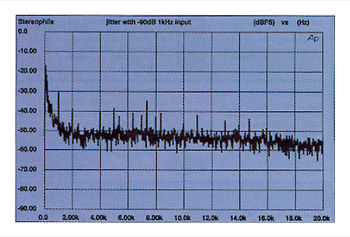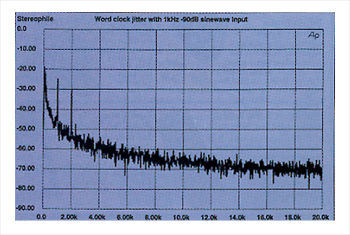| Columns Retired Columns & Blogs |
Can one correlate intersample overs to the square wave phenomenon JA is referring to here? That is, Philips, Wadia, Pioneer's Legato Linear, and Meitner do not "compress" the overs?

Fig.15 Average CD player, word-clock jitter spectrum, DC-20kHz, when processing 1kHz sinewave at -90dBFS (linear frequency scale, 10dB/vertical div., 0dB=1ns).

Fig.16 Excellent CD player, word-clock jitter spectrum, DC-20kHz, when processing 1kHz sinewave at -90dBFS (linear frequency scale, 10dB/vertical div., 0dB=1ns).
Tracking & error correction
A test we perform on CD players and transports checks the tracking and error-correction ability of the unit. The Pierre Verany Test Disc (Pierre Verany PV-784031) has a section with data dropouts of increasing length (you can easily see these by looking at the disc). The higher the track number in this series, the longer the dropout. By listening for when the test tone is interrupted and noting the track number, the dropout length the player can correct without error can be determined. The higher the track number, the better; track 35 is the typical limit.
When a processor under test is on the bench, we make sure it will lock to 32kHz and 48kHz sampling frequencies by driving it with the System One's digital signal generator at those sampling frequencies.
Summing up
I must reiterate that good bench performance doesn't guarantee high sound quality. Moreover, there's absolutely no way to predict a component's sonic character from looking at test results. Nevertheless, a product that sounds good and measures well inspires more confidence than one that performs poorly on the test bench.

Can one correlate intersample overs to the square wave phenomenon JA is referring to here? That is, Philips, Wadia, Pioneer's Legato Linear, and Meitner do not "compress" the overs?